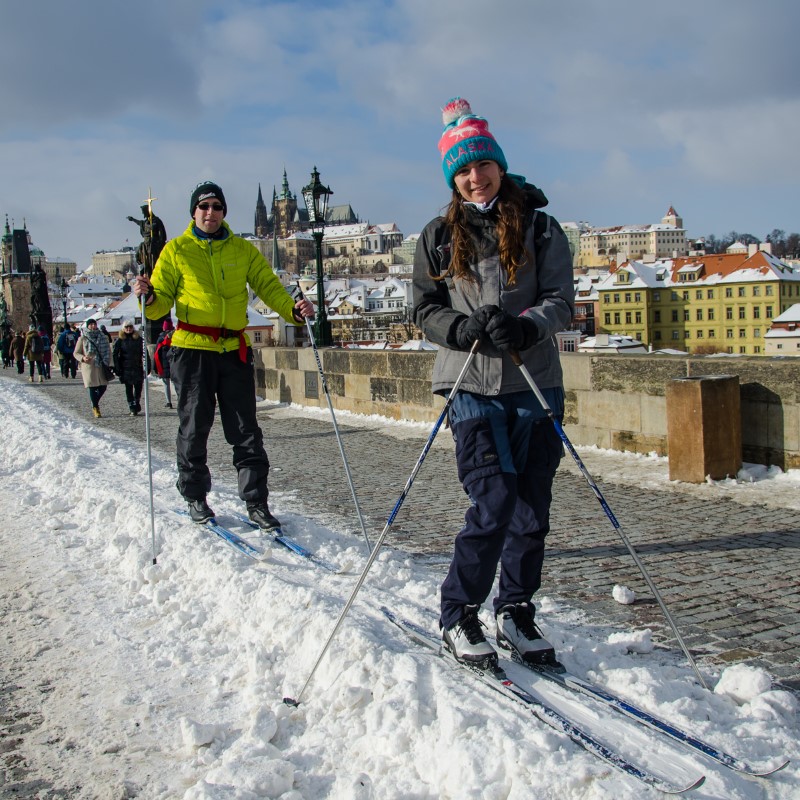
Written by local experts Adriana & Matěj
Adriana and Matěj Halouskovi are travel bloggers behind the successful blog Czech the World.
Matěj was born in Prague and has lived here his entire life and Adriana moved here 6 years ago.
We have traveled to more than 60 countries, but if we could tell you what place we know the most, it is our city.
Welcome to the enchanting world of Prague’s mysterious legends, where history and myth intertwine in the city’s cobblestone streets and hidden corners.
In this article, we delve into the enigmatic tales that shroud some of Prague’s most famous landmarks. From dark stories haunting the Old Town to inexplicable events that still stir curiosity, each legend is anchored to a specific place in Prague.
You’ll have the chance not only to read about these legends but also to visit the actual spots and experience the mystique firsthand. Let’s embark on a journey to uncover the 13 most mysterious legends of Prague, a must-know for every traveler venturing into this historic city.
1) The Charles Bridge Construction
The oldest bridge in Prague, Charles Bridge, was built in 1402 on the site of the former Judith Bridge. This iconic structure is shrouded in a plethora of legends, among which the tales about the mortar used in its construction are the most famous.
In medieval times, mortar was indeed fortified in various ways – with milk or curd, ox blood and bile, and even beer and wine.
However, when the builders from Velvary brought hard-boiled eggs instead of raw ones (to prevent them from breaking during transport), and cheese instead of milk from Unhošt, it was met with great ridicule.
Apologies to legend enthusiasts for the unflattering punchline, but it must be mentioned that a 2010 analysis of the original mortar from Charles Bridge by scientists at the University of Chemistry and Technology, Prague, revealed that eggs were not used in the construction. However, it is proven that the mortar was indeed mixed with milk and wine.
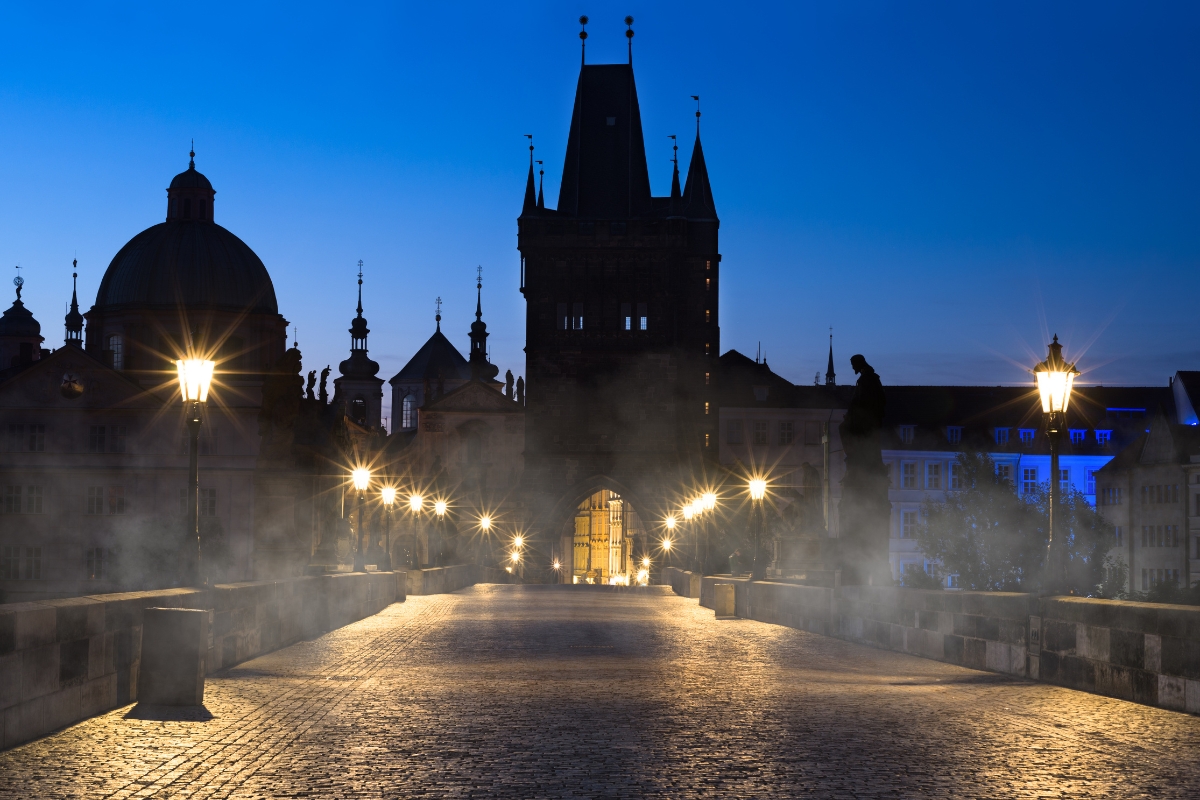
2) The Tale of Jan Nepomucký
The story of Jan Nepomucký, a revered figure in Czech history, centers on his tragic demise at the Charles Bridge in Prague. As a priest, Jan Nepomucký found himself entangled in a conflict with King Wenceslas IV. The King demanded to know the Queen’s confessions, which Jan, as her confessor, refused to divulge, valuing the sanctity of the confessional seal.
This defiance led to his arrest and torture. Ultimately, in 1393, he was thrown from the Charles Bridge into the Vltava River, where he drowned, sealing his fate as a martyr.
His death is commemorated by a monument on the bridge, marking him as a symbol of resistance against tyranny and the upholder of the confidentiality of confession.
The Tradition of Touching St. John Nepomuk’s Plaque
On Charles Bridge, a long-standing tradition among tourists and locals alike involves touching the plaque on of St. John Nepomuk. It’s believed that touching the plaque brings good luck and ensures a return to Prague.

3) The Legend of the Golem
Prague’s air of mystery is deepened by the legend of the Golem. The tale recounts that a Jewish rabbi, Judah Loew ben Bezalel, created the Golem to protect the Jewish ghetto from Christian persecution.
The Golem was brought to life by a shem, a sacred inscription, placed within it. But how was the Golem created? Rabbi Loew once had a dream in which a message appeared: “Create a creature from clay to protect against your enemies!” And so, he did.
Days later, Rabbi Loew, along with two scholars, dressed in white robes and ventured out of the city at night. By dawn, they reached a spot near the Vltava River, where they found the perfect, fine, and moist clay. Together, they molded the clay into a giant human figure – the Golem. After performing secret rituals, the Golem awakened and opened its eyes. From that moment, it guarded the Jewish quarter, especially at night.
However, the Golem’s strength grew uncontrollably. This culminated in an incident when Rabbi Loew forgot about the Golem, leading it to go on a destructive rampage. Rabbi Loew had to interrupt his synagogue service to stop the Golem. He commanded it to halt, removed the original shem, and replaced it with a new one.
The Rabbi then ordered the Golem to rest in the attic of the Old-New Synagogue. Obeying, the Golem fell asleep there, and Rabbi Loew, along with his assistants, began reciting the life-giving formula in reverse. The Golem weakened, crumbled, and eventually turned to dust. Access to the synagogue’s attic was then forbidden.
This ban was respected for many years until the 18th century when the scholar and Chief Rabbi of Prague, Ezekiel Landau, ventured into the attic. Reportedly, he returned pale and trembling, immediately reinstating the ban without revealing what he saw.
Was it just a legend, or is there a hint of truth in it? That remains a mystery, and we are left only with the legends. Whether to believe or not is up to you.
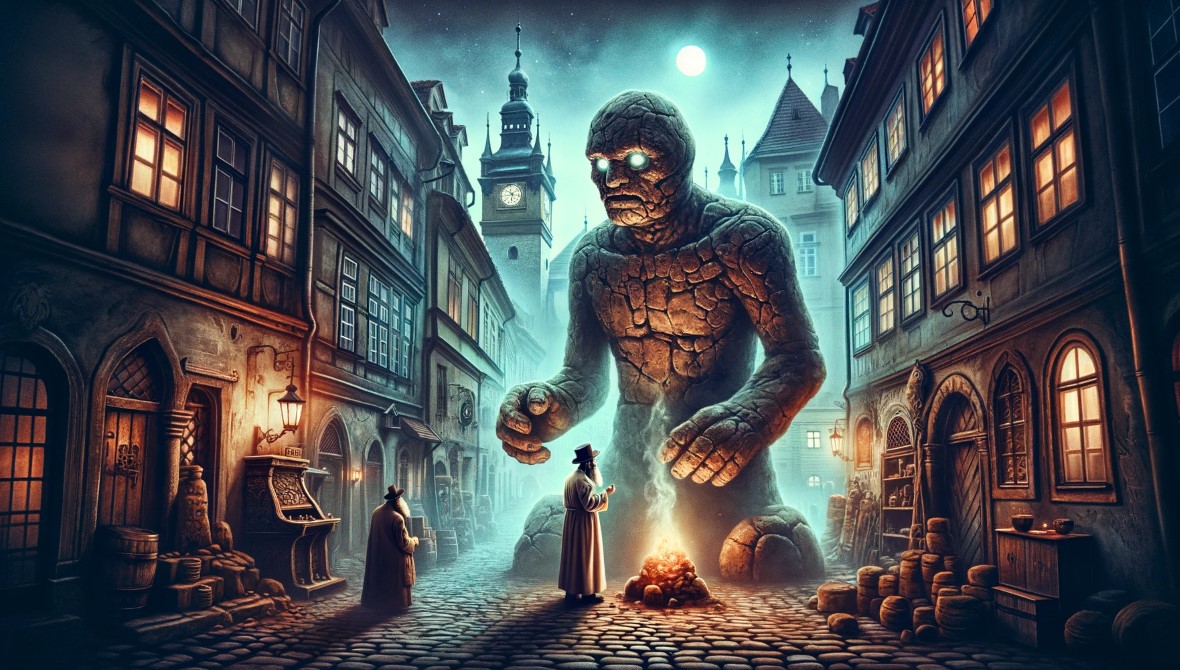
4) Dr. Faust and His House
On Karlovo náměstí in New Town, Prague, stands one of the city’s most enigmatic buildings – the Mladota Palace, also known as the Faust House.
Alchemical Mysteries: Edward Kelley and Ferdinand Antonín Mladota
This mysterious dwelling was not only home to the alchemist and mystic Edward Kelley but also to the eccentric Ferdinand Antonín Mladota of Solopysk, who was deeply involved in devising apparatus based on optics, electricity, and magnetism.
Mladota created figures that moved on spring mechanisms and other phenomena that at the time, seemed inexplicable, fueling rumors that he was in league with the devil.
Pastor Karl Jaenig: Eccentricity Behind the Pulpit
For several years, the house was occupied by Pastor Karl Jaenig. Despite his clerical profession, Jaenig was another eccentric character, known for his extensive collection of funerary items linked to death. Rumors sometimes even cast him as a vampire, allegedly sleeping in a coffin surrounded by skulls, bones, and pieces of gallows.
Hidden Secrets Within the Faust House
Over its history, the house has revealed treasures like valuable wall paintings, walled-in children’s shoes, and skeletal remains of cats – believed to have been entombed to protect the house and imbue it with mystical powers.
The Legend of Dr. Faust and His Deal with the Devil
There’s also a legend of a mythical spring within the house. An opening in the ceiling, large enough for an adult to pass through, gave rise to the Faustian legend – the learned Dr. Faust is said to have made deals with the devil here.
The devil assisted him in his work and fulfilled his tasks until the appointed hour when Faust had to pay with his soul. Faust resisted and tried various formulas to evade his fate, but the devil overpowered him and flew out through the ceiling, leaving behind an unsealable black hole.
Underground Passages and Remodeling Over Time
Another legend suggests an underground passage from the house to the New Town Hall. The Faust House, adjacent to the magnificent Dientzenhofer Gate from around 1740, was originally a Gothic structure now remodeled in Baroque style.

5) Libuše’s Vision and the Birth of Prague
Undoubtedly, one of the most memorable places of the Czech nation is Prague’s Vyšehrad. One legend states that it was here that Princess Libuše uttered her famous prophecy about the future of Prague: “I see a great city, whose glory touches the stars.” Libuše, celebrated for her prophetic leadership, shaped the Czech people’s destiny with her visionary insights.
Libuše’s unconventional decision-making was most evident in her personal life. Eschewing typical royal matches, she chose to marry a ploughman named Přemysl, spotted in a vision working in the fields near Stadice. This choice, based on her mystical foresight rather than traditional expectations, marked her unique approach to leadership.
Similarly, the foundation of Prague stemmed from her prophetic vision. Libuše envisioned a grand city near the river Vltava, approximately 4.5 kilometers from their location, destined to achieve stellar fame. Her people, having faith in her mystical wisdom, ventured to the indicated spot. There, they encountered a man constructing a threshold (‘práh’ in Czech) for his house. And from this, Praha (Prague in Czech) was born.

6) The Mysterious Devil’s Column
The enigmatic Devil’s Column, located in the Karlovy Zahrady at Vyšehrad since 1888, consists of individual pieces measuring between 160 to 240 cm in length.
Legend has it that the column was transported to Vyšehrad by the devil himself, who bet a local priest he could bring a column from St. Peter’s Basilica in Rome before the priest finished Mass.
Geological analysis revealed that the structure is not made of a single column but at least two different ones! Moreover, the stone doesn’t originate from the Prague area but from a quarry in Krhanice, near Kamenný Přívoz on the Sázava River.
The true origin of these stone columns remains unclear. Theories about the column’s purpose vary, ranging from it being an ancient timekeeping device or milestone, to a medieval pillory.
The most likely hypothesis is that it was originally part of the Romanesque Basilica of St. Peter from the 11th or 12th century.
Traditional archaeology suggests that it’s a pre-Christian monolith used for astronomical purposes, dating back to sometime between the 5th and 10th centuries AD.

7) The Tale of Dalibor and His Violin
Within the Prague Castle complex lies the Daliborka Tower, a part of the castle’s late Gothic fortifications and a site rich in myths and ghost stories.
Originally a nobleman’s prison, the tower later housed commoners until its closure in the late 18th century. It’s named after its first inmate, Dalibor, a knight from Kozojedy. Dalibor, often likened to Robin Hood, was imprisoned for harboring rebellious serfs.
Legend has it that he learned to play the violin in his dark cell, enchanting Prague’s citizens with his music. People, moved by his melodies, would gather around the tower, offering him food and drink.
Dalibor’s music made him beloved, and his execution was kept secret. It was only known he had been executed when the music stopped. A visit to the Prague Castle, especially in the evening, brings this eerie tale to life.
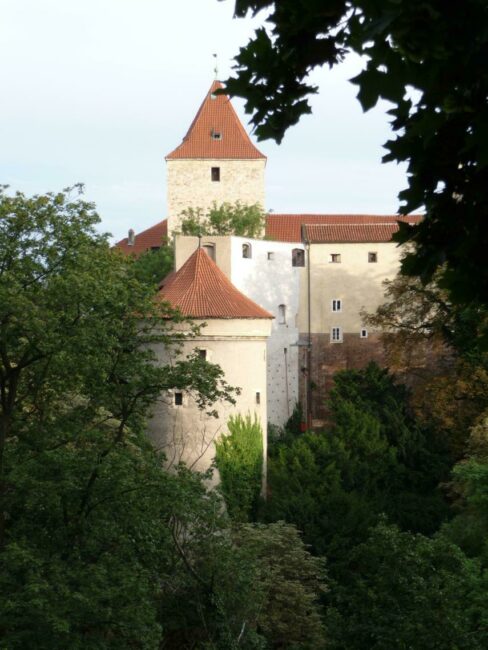
8) The Death of Tycho Brahe
The death of the famed astronomer Tycho Brahe is intricately linked with one of Prague’s most significant historical landmarks – the Gothic Church of Our Lady before Týn, commonly known as Týn Church.
Inside, visitors can view the tomb of this celebrated astronomer. The church boasts 19 exquisitely carved altars in the early Baroque style.
Notably, the church’s towers are asymmetrical; the southern tower is larger, more robust, and ornately decorated. Standing at 80 meters tall, they are the second highest in Prague.
Brahe’s tomb has been opened twice for examination, in 1901 and 2006. Contrary to popular belief, he did not die from a ruptured bladder, a physiologically implausible cause.
Speculation among scientists about mercury poisoning has been rife. One theory suggested that Brahe was murdered by his rival, Kepler. Indeed, traces of mercury found in his body lent some credence to this hypothesis. This mercury could have led to a kidney inflammation, which is the most likely cause of his death.
However, the means by which mercury entered his system remains a mystery. Modern investigations in 2006 have dispelled much of the mystery, revealing only trace amounts of mercury in his body, thus confirming that he died of natural causes.
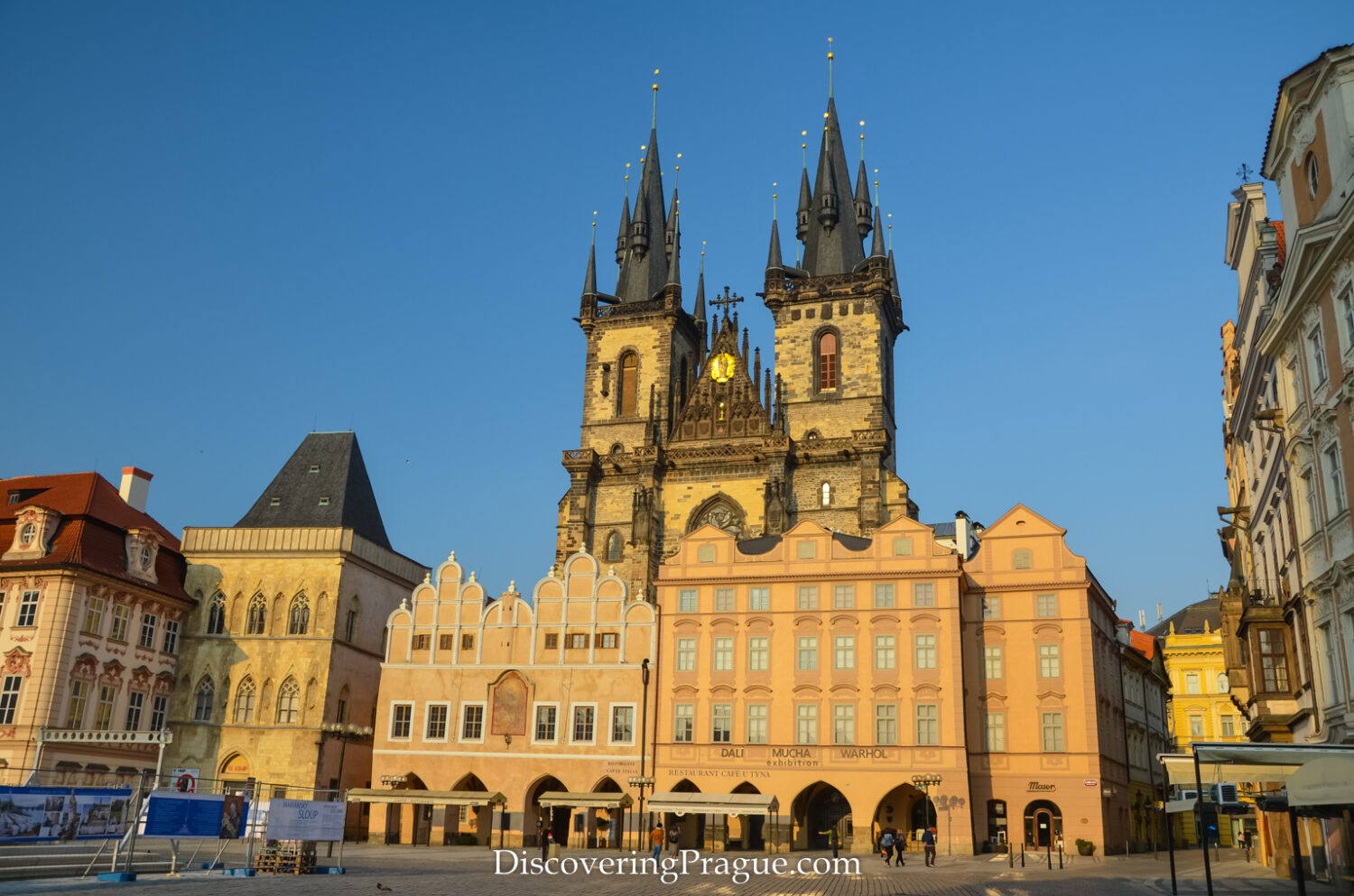
9) Origin of the Czech Nation
The story behind why Czechs are called so is rooted in legend and history. The tale involves three brothers: Czech, Lech, and Rus, who embarked on a journey across Europe to find new homes for their tribes. Rus found his place first and settled, founding what is now Russia.
Czech and Lech continued their journey until they reached a hill, now known as Říp. From its summit, Czech saw a land he described as the “land of milk and honey” and chose it for his tribe. In honor of their leader, the tribe adopted the name ‘Czechs’. As for Lech, he journeyed further and eventually settled in what is now Poland.
This story, blending myth with historical identity, places the origin of the Czech people in a broader European context. Říp Hill, located about 50 km north of Prague, remains a symbol of this legend.
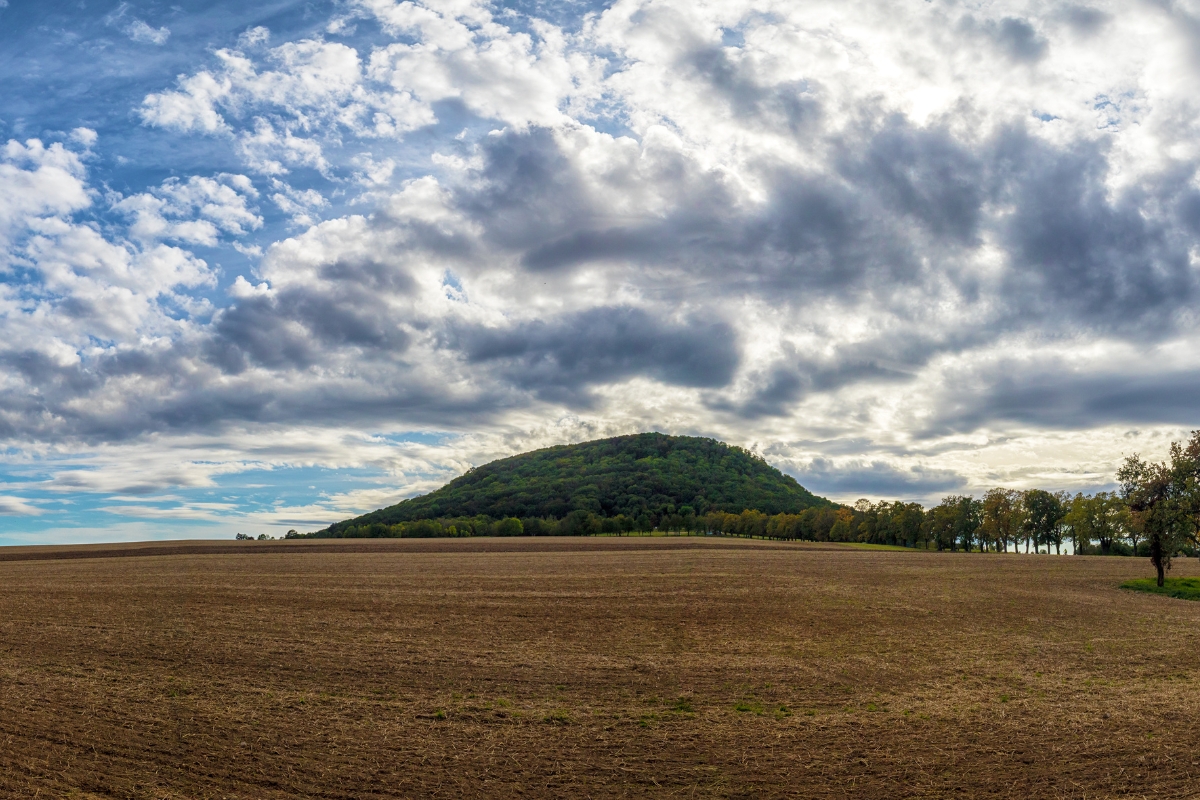
10) Horymír and Šemík: A Tale of Bravery
In the time of Prince Křesomysl, a farmer named Horymír from Neumětely had a remarkably intelligent white horse named Šemík. Disagreeing with Křesomysl’s push for mining over farming, Horymír warned of impending famine, leading to conflict with the miners. After an escalation of violence, Horymír was sentenced to execution.
For his last wish, Horymír requested a final ride on Šemík around the castle. Whispering to Šemík, they miraculously jumped over the castle ramparts and escaped across the Vltava River. The jump, however, fatally exhausted Šemík, who asked Horymír in a human voice to build him a tomb. Šemík is said to rest in the Vyšehrad rock, awaiting a time when his bravery will be needed again.

11) The Headless Specters of the House at the Golden Well
In the shadowy alleys of Prague’s Old Town, tales of headless ghosts abound, as if the city has become a magnet for such spectral figures from all over Bohemia.
For instance, a local legend associated with one of the most beautiful houses in Prague – the House at the Golden Well, located at the corner of Karlova and Seminářská streets – speaks of the apparitions of a headless Spanish knight and his wife, who were once murdered there. The house is known for its narrow staircase, so narrow that when the undertakers arrived, they had to lower the bodies out of a window in their coffins, as they couldn’t fit down the stairs.

12) The Midnight Ghost of the Templar Knight
Near St. Vavřinec Church on Liliová Street, every Friday at midnight, the ghost of a headless Templar Knight, carrying his own head under his arm and riding a horse with flames shooting from its nostrils, is said to haunt the area. The church was part of the Prague Templar commandery, and long after the order’s dissolution in the early 14th century, it was still referred to as “In Jerusalem.”
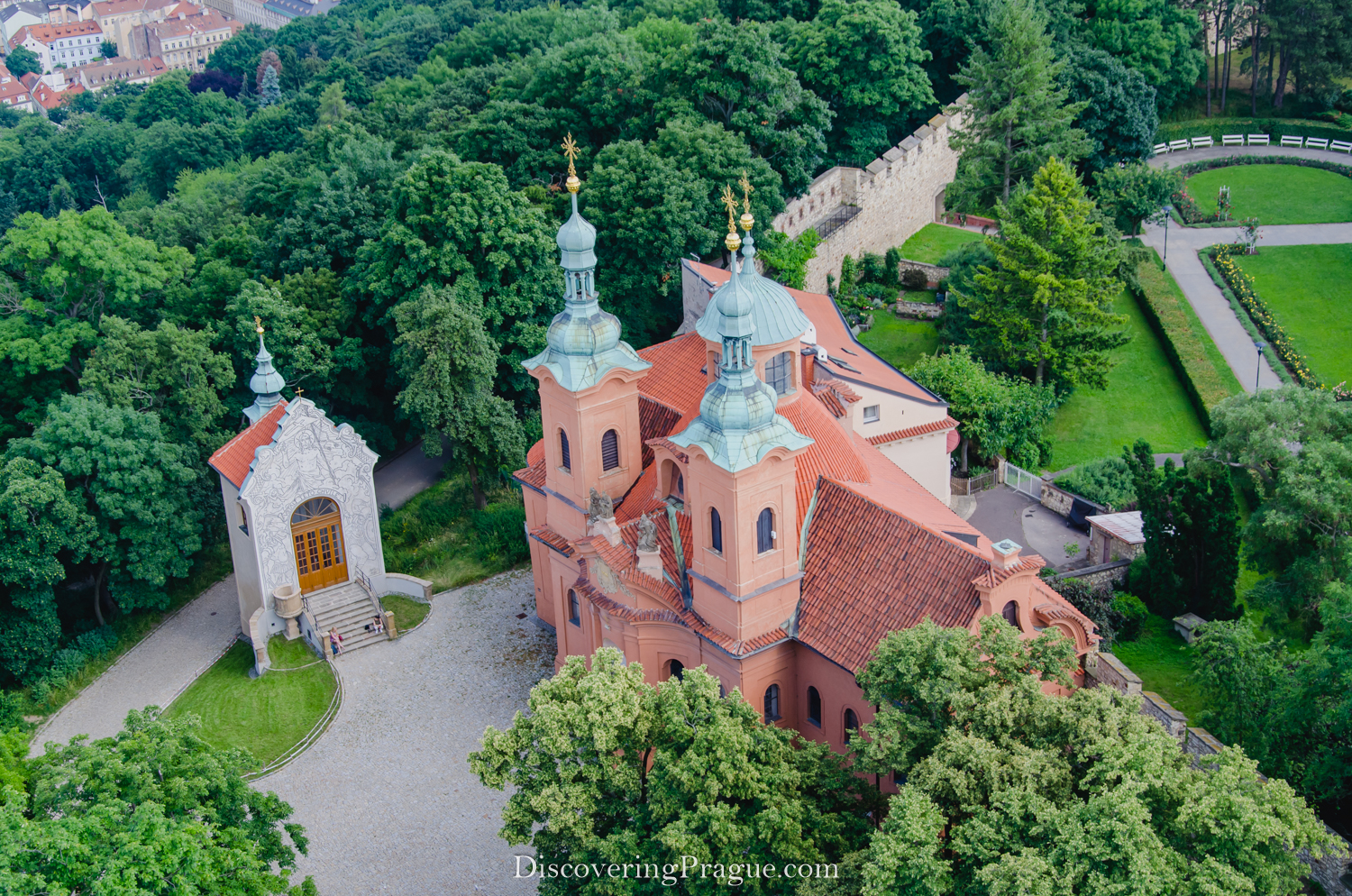
13) The Cursed Iron Knight of Prague
The oldest house sign in Prague is the Gothic emblem of the House of the Iron Man, now preserved in the Museum of the City of Prague. Legend has it that a knight, after killing his lover, was turned into an iron sculpture – the very same house sign. A curse dictates that he can only be freed once every hundred years by a young girl. This has yet to happen, although it once came close. A terrified mother, learning of her daughter’s intent to meet the ghost at midnight, locked her in the cellar and went in her place. But upon realizing that it was not a young girl but a mature woman, the ghost of the murderous knight vanished with a sigh.
Pin Prague Legends for later or for your friends:
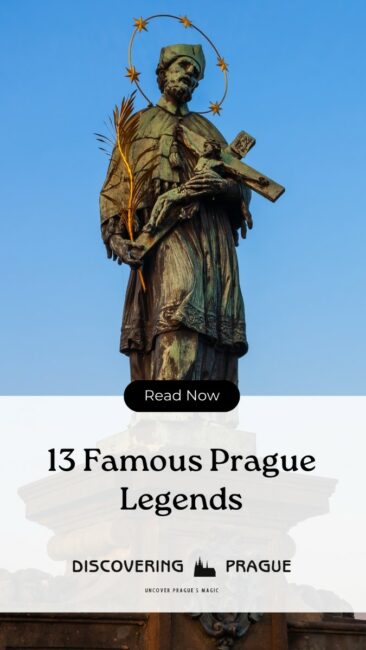
Did this post about Legends of Prague help you? Share it with your friends! It can help them.

